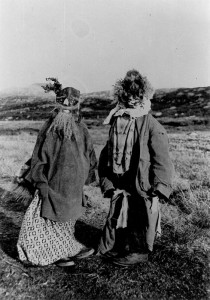Samhain - Halloween
To celebrate this rather spooky time of year, Gaelic lecturer Catriona Murray shares the ancient Celtic history of Halloween, read on if you dare...
You’ve probably noticed that the shops are full of pumpkins, witches’ hats and sweets for Halloween. Maybe you think this is just yet another American fad that’s caught on over here. However, its roots lie in something very ancient and very Celtic: the fire festival of Samhain.
Samhain marked the end of one pastoral year, and the beginning of the next and was, in one sense, a celebration of darkness. Not of spiritual darkness, not a glorification of the occult - but thanksgiving for the rest nature enjoys in the months of winter. Our forefathers understood, as we do not, that a seed does most of its growing out of sight, underground, in the dark. So it is for all of nature. Therefore, darkness was viewed not as a mark of death or decay, but an opportunity for renewal.
Think back to the Halloween parties of your youth. Bowls of nuts would be very much in evidence, as well as the basin filled with water and apples for ducking. These were a throwback to the harvest-home roots of Samhain... and used in the lost art of divination, which was once a traditional practice on that particular night.
If you want to find out how your relationship (or someone else’s!) will work out, select two nuts, each representing one partner and, this Halloween, pop them in the fire. Their behaviour in the flames will tell you all you need to know! Or, if you want to know who you will marry, select an apple, taking care to remove the peel in one strip. Throw it over your left shoulder on Halloween and it will land in the shape of your loved one’s initial.
What about ghosts and evil spirits, though? It is true that they were a major part of Halloween. The end of the year caused a breach in the continuity of time and our ancestors believed that such a break caused a thinning of the veil between this world and the other. On Halloween, therefore, it was thought that the spirits of the dead could return to warm themselves at the hearths of the living. A wise person learned early, therefore, how to protect themselves from such visitors.
The first defence was knowing what to do - and our forefathers had a store of wisdom in this regard that we have gradually lost sight of over time.
We offer courses that seek to reacquaint people with Gaelic heritage and culture, as well as the language itself. We believe that it is important not to lose sight of the wealth of knowledge and information that is part of the fabric of the Gaelic community.
We have a suite of courses which provide something for everybody, whether you pursue an interest in place names or folklore on one of our short courses, improve your Gaelic via Ulpan online, or undertake one of our degree programmes, or CPDs.
Find out more about our Gaelic courses
Search our Gaelic short courses
Our courses are supported by Bòrd na Gàidhlig.
Image by Margaret Fay Shaw, shared by kind permission of The National Trust for Scotland - https://www.nts.org.uk/stories/the-photographic-archive-of-margaret-fay-shaw
